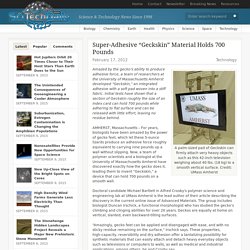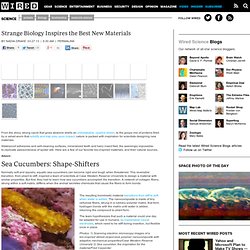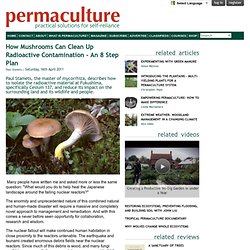

Super-Adhesive "Geckskin" Material Holds 700 Pounds. A palm-sized pad of Geckskin can firmly attach very heavy objects such as this 42-inch television weighing about 40 lbs. (18 kg) to a smooth vertical surface.

Credit: UMass Amherst Amazed by the gecko’s ability to produce adhesive force, a team of researchers at the University of Massachusetts Amherst developed “Geckskin,” an integrated adhesive with a soft pad woven into a stiff fabric. Initial tests have shown that a section of Geckskin roughly the size of an index card can hold 700 pounds while adhering to flat surface and can be released with little effort, leaving no residue behind. AMHERST, Massachusetts – For years, biologists have been amazed by the power of gecko feet, which let these 5-ounce lizards produce an adhesive force roughly equivalent to carrying nine pounds up a wall without slipping.
“Amazingly, gecko feet can be applied and disengaged with ease, and with no sticky residue remaining on the surface,” Irschick says. The work was supported by the U.S. Strange Biology Inspires the Best New Materials. From the shiny, strong nacre that gives abalone shells an unbreakable, opaline sheen, to the goopy mix of proteins fired by a velvet worm that solidify and trap prey upon impact, nature is packed with inspiration for scientists designing new materials.

Waterproof adhesives and self-cleaning surfaces, mineralized teeth and hairy insect feet, the seemingly impossible-to-replicate awesomeness of spider silk: Here are a few of our favorite bio-inspired materials, and their natural sources.Above:Sea Cucumbers: Shape-Shifters Normally soft and squishy, aquatic sea cucumbers can become rigid and tough when threatened. This reversible transition, from pliant to stiff, inspired a team of scientists at Case Western Reserve University to design a material with similar properties.
But first, they had to learn how sea cucumbers accomplish the transition: A network of collagen fibers, strung within a soft matrix, stiffens when the animal secretes chemicals that cause the fibers to form bonds. Ask Nature. How Can Designers and Architects Use Biomimicry to Stay on the Cutting Edge of Innovation? Shortly before his death in 2011, Steve Jobs said, “I think the biggest innovations of the 21st century will be at the intersection of biology and technology.

A new era is beginning.” The crossroads that he spoke of actually has a name – biomimicry – and while it has been helping inventors, designers and architects innovate in genius ways for centuries, its value has become even more apparent in the past few years as we realize that Mother Nature is one of the universe's most incredible designers. If you're not yet familiar with biomimicry, it's a word that describes finding design inspiration from nature to solve human problems. There are examples of biomimicry all around us – velcro, airplanes, solar panels modelled on ivy, and even buildings modelled after termite mounds. This robotic spy plane that mimics the shape and function of a bat in flight is one example of biomimicry.
Paul Stamets on 6 ways mushrooms can save the world. How Mushrooms Can Clean Up Radioactive Contamination - An 8 Step Plan. Many people have written me and asked more or less the same question: "What would you do to help heal the Japanese landscape around the failing nuclear reactors?

" The enormity and unprecedented nature of this combined natural and human-made disaster will require a massive and completely novel approach to management and remediation. And with this comes a never before seen opportunity for collaboration, research and wisdom. The nuclear fallout will make continued human habitation in close proximity to the reactors untenable. The earthquake and tsunami created enormous debris fields near the nuclear reactors.
Since much of this debris is wood, and many fungi useful in mycoremediation are wood decomposers and build the foundation of forest ecosystems, I have the following suggestions: 1. 2. 3. 4. 5. 6. 7. 8. By sampling other mushroom-forming fungi for their selective ability to hyper-accumulate radioactivity, we can learn a great deal while helping the ecosystem recover. Mycellium Running. Why We Need Mushrooms. For the last 30 years Paul Stamets has collected, cultivated, studied and written about mushrooms.

He’s the founder of Fungi Perfecti, a company that sells a variety of mushroom-related products, including kits for growing edible mushrooms. He’s also written several books, including Growing Gourmet and Medicinal Mushrooms, and Mycelium Running: How Mushrooms Can Help Save the World. Yep, you read that right: Stamets’ new book tells us how mushrooms can help save the world. If that idea sounds like a stretch, prepare to have your mind expanded.
Stamets has done extensive research on the practical ways people can use mushrooms to heal ourselves and protect the planet. Stamets took the time to answer our questions about the health and environmental benefits of mushrooms. Mushrooms, Mycelium and the Planet Your latest book is called Mycelium Running.